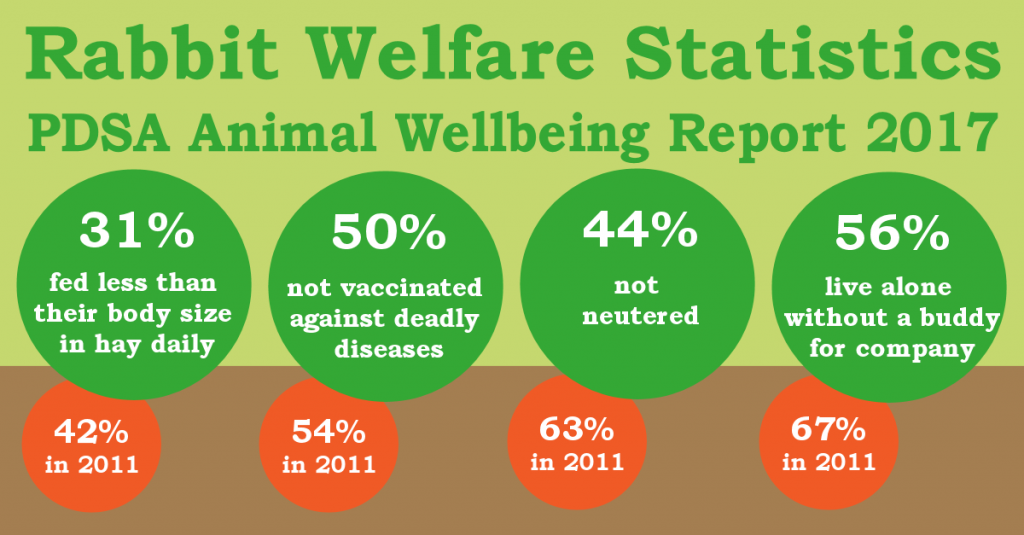Rabbit Welfare Statistics – PAW Report 2017
The PDSA have just released their 2017 PAW (PDSA Animal Wellbeing) Report. This report looks closely at the welfare of pet dogs, cats and rabbits in the UK by surveying owners and vets. It’s fascinating stuff because it provides statistics that let you track key welfare trends like neutering and diet over the last 7 years. If you’ve ever wondered “are things getting better?” this report can give you a firm yes or no. You can see my review of previous years reports here.

Diet
To report uses two key factors to judge the quality of rabbits’ diets – whether rabbits are fed pellets or muesli (studies have shown muesli is less healthy than pellets) and whether rabbits eat enough hay (a portion about the size of their body).
The good news is that there has been a significant decline in people feeding muesli, from 49% in 2011 to 25% in 2017. This probably reflects the amount of publicity about the downsides to muesli around 2013, which led to some stockists and pet food manufacturers stopping sales. The bad news is most of that decline was in 2013/14 and the proportion feeding it has remained fairly static since.
There is also good news on hay, the amount of rabbits not eating a suitable sized portion has declined from 42% in 2011 to 31% in 2017. Again though, there is still a stubborn portion that aren’t feeding enough hay and it’s actually risen slightly from a low of 26% in 2013/15.
This years Rabbit Awareness Week (17-25th June) is focusing on diet. The great thing about the PAW Report is we’ll be able to look at the 2018 one and see if it has any influence. Part of the difficulty with improving welfare is you have rabbit owners that look out for new information and are therefore easy to reach, but also a group who aren’t getting the welfare messages. One of the things the report highlighted is that there is a big split between the welfare of rabbits that are registered with a vet and not e.g. only 17% of rabbits registered with a vet are fed muesli, where as 41% not registered with a vet are fed muesli. Vets are a really valuable information source for how to care for your pet properly – not just somewhere to go when your bun is sick.
Companionship
Rabbits are social animals so another key gauge of welfare is whether they have a companion. In 2017 44% of rabbits have a companion, a rise from 33% in 2011. Whilst that’s still quite low it’s nice there has been an increase.
The 2016 report had a little more detail on the living arrangements of bunnies:
52% Lived on their own
20% Lived with a rabbit of the opposite sex
17% Lived with a rabbit of the same sex
3% Lived with more than one rabbit of different sexes
1% Lived with more than one rabbit of the same sex
1% Lived with one or more guinea pigs
Note the similar numbers living with the same sex and opposite sex – this is interesting as matching up opposite sex neutered rabbit’s is what’s most frequently promoted. Of those rabbits living with companions, 64% of the rabbits involved were all neutered and 23% none were neutered – hopefully that later group are from the same sex category!
Neutering
In 2017 56% of rabbits are neutered, up from 37% in 2011 – there’s been nice steady upwards trend and I imagine it’s helped the upward trend in companionship too. These changes take time, seven years isn’t even the life time of one rabbit so seeing an improvement over what’s really quite a short period is great. As people tend to be reluctant to neutered older animals, it’s hopefully a sign that more young rabbits are being neutered and therefore the total neutered will continue to grow.
Vaccinations
The first few PAW reports just looked at whether rabbits were vaccinated or not – 46% vaccinated in 2011. Later reports have split this into primary vaccination (the first one) and boosters. In 2017 50% of rabbits had a first vaccination and 45% regular boosters.
Considering the prevalence of Myxomatosis and the new strain of VHD2 it’s worrying how few rabbits are vaccinated. The reason they aren’t vaccinated is also worrying – 32% said they thought vaccinations were unnecessary and 10% too expensive. Whilst cost isn’t something we can easily fix, if 16% of rabbits are unvaccinated because their owner didn’t realise it was necessary then we need to do some more education!
Housing
Indoor v outdoor can be a bit of a hot topic. In general the UK tends to see living outdoors as more normal for rabbits than some countries i.e. the US. So 41% of rabbits living predominantly inside was higher than I would have guessed.
I think it’s important that we don’t equate indoor with good housing and outdoor with bad though. Housing a rabbit inside doesn’t automatically mean it’s environmental needs are met, it’s very much down to the actual environment provided. Overall the report found 35% of rabbits were housed inappropriately, including 15% inside. A small cage is a small cage whether it’s in or out.
Behaviour
Last of all a little snippet on behaviour, a topic I’m rather fond of, so this one interested me – 44% of owners reported their rabbit displayed one or more unwanted behaviours that they’d like to change (including thumping and biting the cage bars). That’s a very high figure. It’s also worrying what that could mean for welfare – unwanted behaviours such as bar chewing can be a sign a rabbit’s needs aren’t being met. When the behaviours make rabbits tough to live with, they can also lead to rabbits being given up to rescues.
If you have a cage bar rattler/chewer I’ve an article on resolving it here: Rabbit Behaviour Problem: Chewing the Cage Bars.
Conclusion
So is rabbit welfare improving? The PAW Report shows that yes it is. We have made some positive progress in quite a short period, whilst there is clearly a lot more to do we have to accept it takes time to filter down education to 1.1 million or so rabbit owners. Those that work hard to educate people about rabbits’ needs should give themselves a pat on the back – keep up the good work it does make a difference!
What do you think are the biggest issues to rabbit welfare and how can we tackle them?
You can download the full report here: https://www.pdsa.org.uk/get-involved/our-current-campaigns/pdsa-animal-wellbeing-report
Tags: paw, rabbit-welfare

